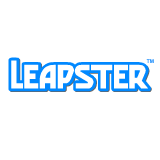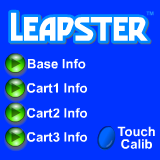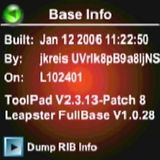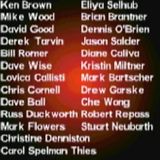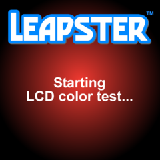Leapster
| Leapster |
|---|
|
Developer: LeapFrog Enterprises
|
The Leapster was an educational games console (originally meant to be a gaming system, digital book reader and a video player all in one system) meant exclusively for young kids, powered by the magic of Macromedia Adobe Flash and MQX. It appears to have done decently well for its purpose, having a couple of upgrades along the way.
See Leapster2 for information on the Leapster2.
To do:
|
Contents
Diagnostics Menu
A simple diagnostics screen can be accessed by holding down the Hint button and powering the system on. Here, the user can calibrate the touch controls and get information about the cartridge inserted. This menu is also present in the Leapster LGS (the smaller, green model), Leapster L-Max, LeapsterTV and Leapster2 (an upgraded model that has PC connectivity, along with an overclocked CPU and other upgrades). The bigger difference is that the L-Max allows the user to change the video mode between NTSC and PAL. In some regions, SECAM video is available. The LeapsterTV uses a switch near the battery compartment to change between video modes. Although changing the serial number and brightness is present on the Leapster2, it is not present on the earlier Leapster systems.
Super Duper Programmer Mode
When Diagnostics mode has been entered, hold down Hint + Left + A + B. This will present an animation that shows "super duper programmer mode!" and will boot into a new Diagnostics menu. This adds a bit more of features, including the build date, the creator, and what it was made by on either the cartridge or BaseROM info. This mode also adds the ability to dump the RIB info of the cartridge or BaseROM. This mode does not seem to work on the newer revisions of the Leapster2, but it does work on the first revision of the Leapster2 and previous systems.
LCD Test Mode
To get into the LCD Test Mode, boot into the Diagnostics menu and hold Hint + Left + A + B to get into the Super Duper Programmer Mode. Then, hold down Hint + A + Down while pressing B a bunch of times. This should boot you into the LCD Test Mode. The screens should progress automatically. Once done, the SDPM screen will appear and put you back into the Diagnostics menu. The images above are from a different hardware revision. The images below the video match up to the hardware it was recorded on, which is the Leapster L-MAX.
Hidden BIOS Images
Hidden inside the Leapster's BIOS image, 14 Images can be found, along with an animated string of images containing 29 frames.
Dev Message
Right at 0x100 in the BIOS is a small message.
Copyright LeapFrog
Content Approval Screen
Present at 0x420 is the content approval screen:
Lil ducked. The jet zipped past her head. Dust flew, Lil sneezed, and Leap turned red. Then Lil got up, about to yell. Leap gasped, "Look, Lil! Your tooth! It fell!". 'Approved Content' is content that either is created by LeapFrog or has received final approval under contract with LeapFrog. LeapFrog grants you permission to copy these five sentences only if this cartridge contains 'Approved Content'. If you copy these five sentences into your cartridge, a statement will appear on the screen stating that the content has been approved by LeapFrog. If you do not copy these five sentences into your cartridge, a statement will appear on the screen stating that the content has not been approved by LeapFrog. Nothing in these five sentences implies permission to copy them. 152-10346 Leapster BaseROM Universal v1.5 Leap likes his ABCs more than his 1,2,3s. Lily likes her math better, much more than any letter ToolPad V2.2.28 Leapster FullBase V1.0.18 DGoldstein WXP-L0002 Sep 04 2003 10:46:47
The short rhyming verse at the start comes from the "Lil's Loose Tooth" story in the "Leap Into Learning" sample book that came with the original LeapPad.
Unapproved Game Error
To do:
|
Present in hex offset 0x0017DA20 and ending at 0x001817D0 of the BIOS (and even in some Leapster games), is a red screen with a message stating that the game and/or other content is not approved by LeapFrog, displayed when the system detects a cartridge that is missing the five sentences required for the cartridge to be approved.
When this screen is first displayed, a loud 735Hz sine tone is played at max volume. This tone can also be heard when the Leapster encounters a fatal error.
Revisional Differences
To do:
|
Built-in Software
- The utmost original Leapster model, with lights in the D-pad circle and stylus connector, has no built-in software, instead displaying an error message on startup when a cartridge is not inserted. This is also the only known Leapster model without the aforementioned diagnostic menu.
- The updated original Leapster model contains a built-in version of Learning with Leap, missing Catcher Field from the cartridge version, but with secret "web codes" that were usable on a long-defunct service called Leapster World. This model is identifiable with the newer LeapFrog logo stamped on the front, as well as additional availability in Pink, Green, and Red. The lights in the D-pad circle and stylus connector were also removed.
- The smaller, natively green Leapster model features a completely new interface for the built-in software, including Rabbit River and Color Corral, both from Learning with Leap. Also featured are sneak peeks for current and upcoming cartridge games.
- The older Leapster L-Max model, usually in red (although units in blue are known to exist as well), is mostly similar to the green Leapster model in terms of built-in software. The main difference is the displaying of the older LeapFrog logo, during startup, instead of the one stamped on the system. As a result, this model seems like more of a prototype.
- The newer Leapster L-Max model uses the same interface, while replacing the Rabbit River mini game with Scooby-Doo: Scooby Snack Math. Furthermore, many upcoming cartridge games in the "sneak peeks" are now current cartridge games (these teasers originally concluded with the voiceover saying the season and year in which the software would become available).
- Pages missing developer references
- Games developed by LeapFrog Enterprises
- Pages missing publisher references
- Games published by LeapFrog Enterprises
- Pages missing date references
- Games released in 2003
- Games released in October
- Games with hidden developer messages
- Games with hidden development-related text
- Games with debugging functions
- To do
- BIOS/Firmware ROMs
- Leapster games
Cleanup > Pages missing date references
Cleanup > Pages missing developer references
Cleanup > Pages missing publisher references
Cleanup > To do
Games > BIOS/Firmware ROMs
Games > Games by content > Games with debugging functions
Games > Games by content > Games with hidden developer messages
Games > Games by content > Games with hidden development-related text
Games > Games by developer > Games developed by VTech > Games developed by LeapFrog Enterprises
Games > Games by platform > Adobe Flash games
Games > Games by platform > Leapster games
Games > Games by publisher > Games published by VTech > Games published by LeapFrog Enterprises
Games > Games by release date > Games released in 2003
Games > Games by release date > Games released in October
